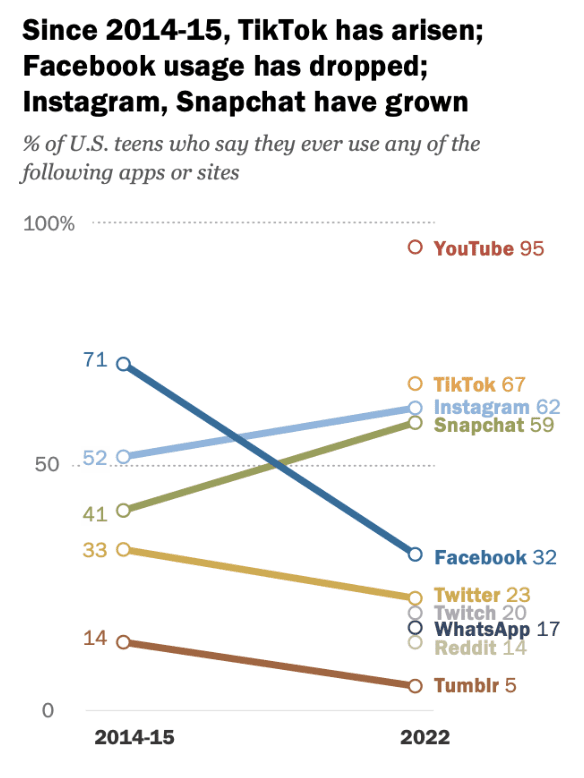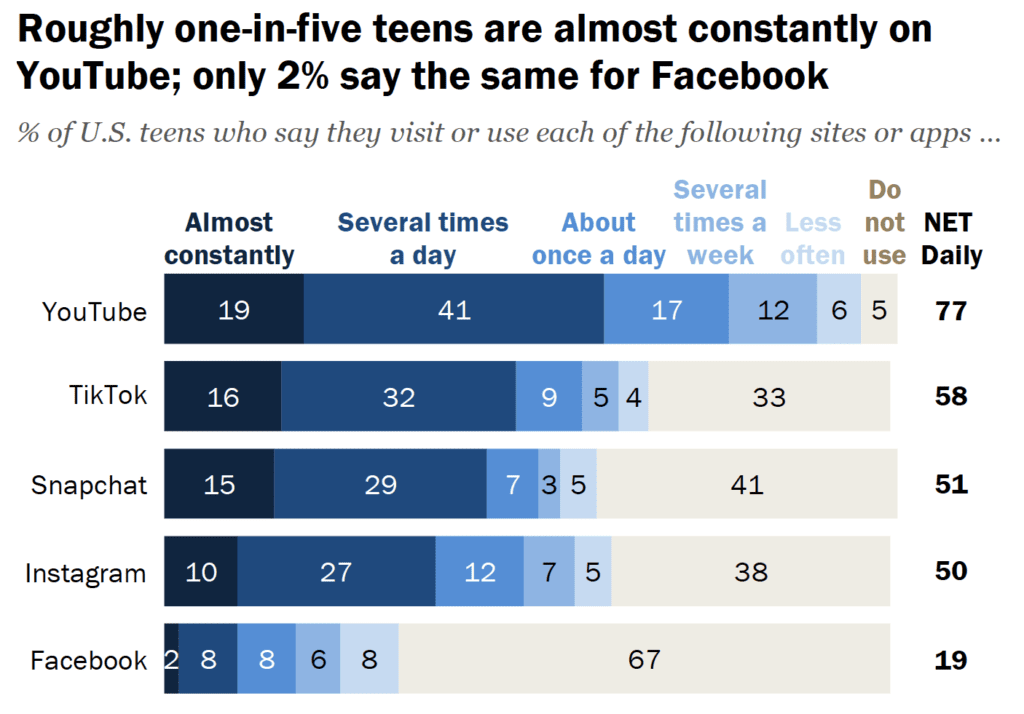How are teens spending their time on social media these days? This is an important question for advertisers. That’s because teens spend money. They talk about their favorite brands with each other. Their preferences influence the popular cultural trends that advertisers need to understand in order to stay relevant. And if advertisers play their cards right, they can, in turn, influence teen behavior.
A new survey of Americans aged 13-17 from Pew Research Center reports some eye-opening findings about where and how teens are spending their time online. Key findings:
- YouTube reigns. 95 percent of teens use YouTube, followed by TikTok, Instagram, Snapchat, and Facebook.
- Only 32 percent use Facebook, compared to 71 percent in 2014-15. Not only is there a smaller share of teenage Facebook users than there was in 2014-15, teens who do use Facebook are also relatively less frequent users of the platform compared to the other platforms covered in this survey. Just 7 percent of teen Facebook users say they are on the site or app almost constantly (representing 2 percent of all teens). Still, about six-in-ten teen Facebook users (57 percent) visit the platform daily.
- Many teens are always on. 46 percent of teens say they’re on the internet “almost constantly,” up from 24 percent in 2014-2015. Roughy one in five teens are almost constantly on YouTube, which leads all platforms.
- The vast majority of teens have access to digital devices, such as smartphones (95 percent), desktop or laptop computers (90 percent) and gaming consoles (80 percent). Since 2014-15, there has been a 22 percentage point rise in the share of teens who report having access to a smartphone (95 percent now and 73 percent then). While teens’ access to smartphones has increased over roughly the past eight years, their access to other digital technologies, such as desktop or laptop computers or gaming consoles, has remained statistically unchanged.
- More affluent teens are particularly likely to have access to all three devices. Fully 76 percent of teens that live in households that make at least $75,000 a year say they have or have access to a smartphone, a gaming console and a desktop or laptop computer, compared with smaller shares of teens from households that make less than $30,000 or teens from households making $30,000 to $74,999 a year who say they have access to all three (60 percent and 69 percent of teens, respectively).
- U.S. teens living in households that make $75,000 or more annually are 12 points more likely to have access to gaming consoles and 15 points more likely to have access to a desktop or laptop computer than teens from households with incomes under $30,000.
- Habits vary by demographic. Teen boys are more likely than teen girls to say they use YouTube, Twitch and Reddit. Teen girls are more likely than teen boys to use TikTok, Instagram and Snapchat. Higher shares of Black and Hispanic teens report using TikTok, Instagram, Twitter and WhatsApp compared with white teens.
Implications for Brands
- Short-form content on TikTok is popular, but so is longer-form content on YouTube. Within just a few years, TikTok has famously rocketed to popularity by featuring videos that are about 30 seconds in length (often shorter). But YouTube’s popularity demonstrates that teens also like more in-depth video content, as Mashable points out. Longer-form content lends itself to content marketing, such as “how to” topics and podcasts, as noted here. On the other hand, shorter-form TikTok videos lend themselves to catchy, engaging micro-moments. To use a television analogy, TikTok is the place for 30-second spots, and YouTube for advertorials. As one influencer on LinkedIn wrote, “If digital media is hunger, TikTok feels like McDonalds, and YouTube feels like [insert fairly decent quality restaurant]. TikTok gives you dopamine hits. It’s addicting, you can become consumed by it, but it doesn’t mean you’re satisfied with the quality. Each swipe is, ‘okay, now what’s next.’ Before you know it, it’s an hour. YouTube, even with most videos watched being through recommendations, provides a deeper connection with the viewer. If you watch a video for >1min, you’re truly invested. This also means that creators will build more meaningful viewer connections through YouTube. All data shows that Gen Z appreciates the quality and connections of YouTube.”
- Teens are not all the same. Variances exist by income level and demographic, as noted above. It’s important to understand the differences depending on your audience. In addition to the statistics cited above, we also noticed the popularity of gaming consoles among more affluent teens. And overall, Hispanic (47 percent) and Black teens (45 percent) are more likely than white teens (26 percent) to say they use at least one of the five most popular social media online platforms almost constantly. And teen girls are most likely to be social media loyal than teen boys: teen girls are more likely than teen boys to express it would be difficult to give up social media (58 percent versus 49 percent). All of these nuances influence any company that wants to launch a credible multi-cultural marketing strategy.
- Facebook still matters, but Instagram does even more. Even though it’s less popular among teens than it was in 2014-15, it’s still more popular with teens than Twitter, Twitch, WhatsApp, Reddit, and Tumblr. As teens get older, they may very well spend more time on Facebook. And Facebook the platform still enjoys widespread usage among adults, as seen in other recent Center studies. However, it’s clear that among Meta’s brands, Instagram is more important for reaching teens, especially as Instagram morphs into a social selling site.
Contact True Interactive
We deliver results for clients across all ad formats, including social media, video, and mobile. To learn how we can help you, contact us.
Photo by Rami Al-zayat on Unsplash



